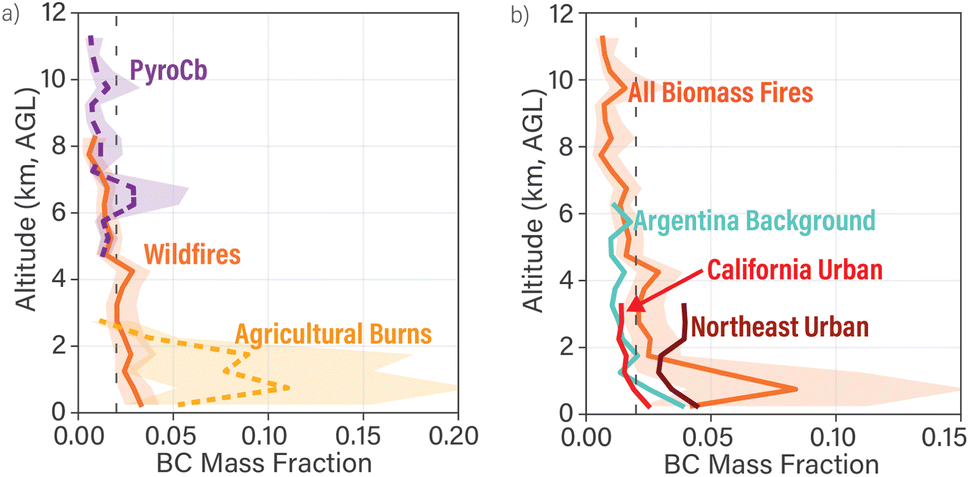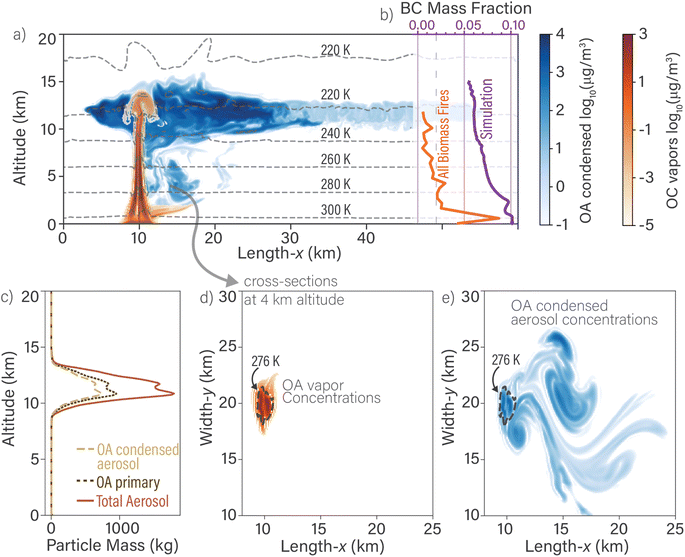Vapor condensation in pyrocumulus smoke raises organic aerosol and lowers black carbon fraction
Submitter:
Dubey, Manvendra K. — Los Alamos National Laboratory
Gorkowski, Kyle — Los Alamos National Laboratory
Area of research:
Aerosol Processes
Journal Reference:
Science
Megafires are increasingly generating pyrocumulus (PyroCu) clouds that loft particles high into the atmosphere to enhance their lifetime and climate forcing. Using aircraft-sampled data in these smoke plumes, we find that the mass fraction of black carbon (BC) is consistently between 0.5 and 3%. Additionally, we provide evidence of the volatile organic vapor condensing in the cold PyroCu updrafts that increases the aerosol mass. Simulations demonstrate organic vapor condensation can double the aerosol mass in updrafts.
Impact
We quantify the aerosol mass and black carbon content that pyrocumulus clouds inject into the stratosphere, a phenomenon exacerbated by the rise in megafires. These aerosols can persist in the stratosphere for 3 to 15 months, influencing the global climate. We find that the black carbon mass fraction within these clouds remains consistent and organic vapor condensation can double the aerosol mass, a critical constraint for climate models. The increasing frequency of megafires has intensified the climatic influence of pyrocumulus clouds, making our work crucial for accurately predicting their environmental impact. Our findings underscore the importance of considering both the vertical distribution of BC mass fraction in wildfire smoke plumes and the role of organic aerosol (OA) in shaping this fraction.
Summary
Megafires with climatic impact have occurred worldwide, injecting stratospheric aerosols that scatter sunlight, cooling the Earth's surface. These plumes can induce both immediate surface cooling (−3 °C) and prolonged global cooling. Given their slow removal (3–15 months from the lower stratosphere), PyroCu smoke plumes produce lasting radiative impacts, unlike their tropospheric counterparts, and are not treated in climate models. We probed the vertical distribution of BC mass fractions in wildfire smoke plumes and the influence of OA formed via condensation on modifying these fractions. We observed a consistently low BC mass fraction (0.5-3 %) -- in the free troposphere -- across different emission locations. This consistency may arise from OA formation, which curtails near-field variability as plumes disperse into the far field. Our chemical data and large-eddy simulations (LES) support vapor condensation in the cold plume updraft that can double the OA mass and reduce the BC mass fraction.



